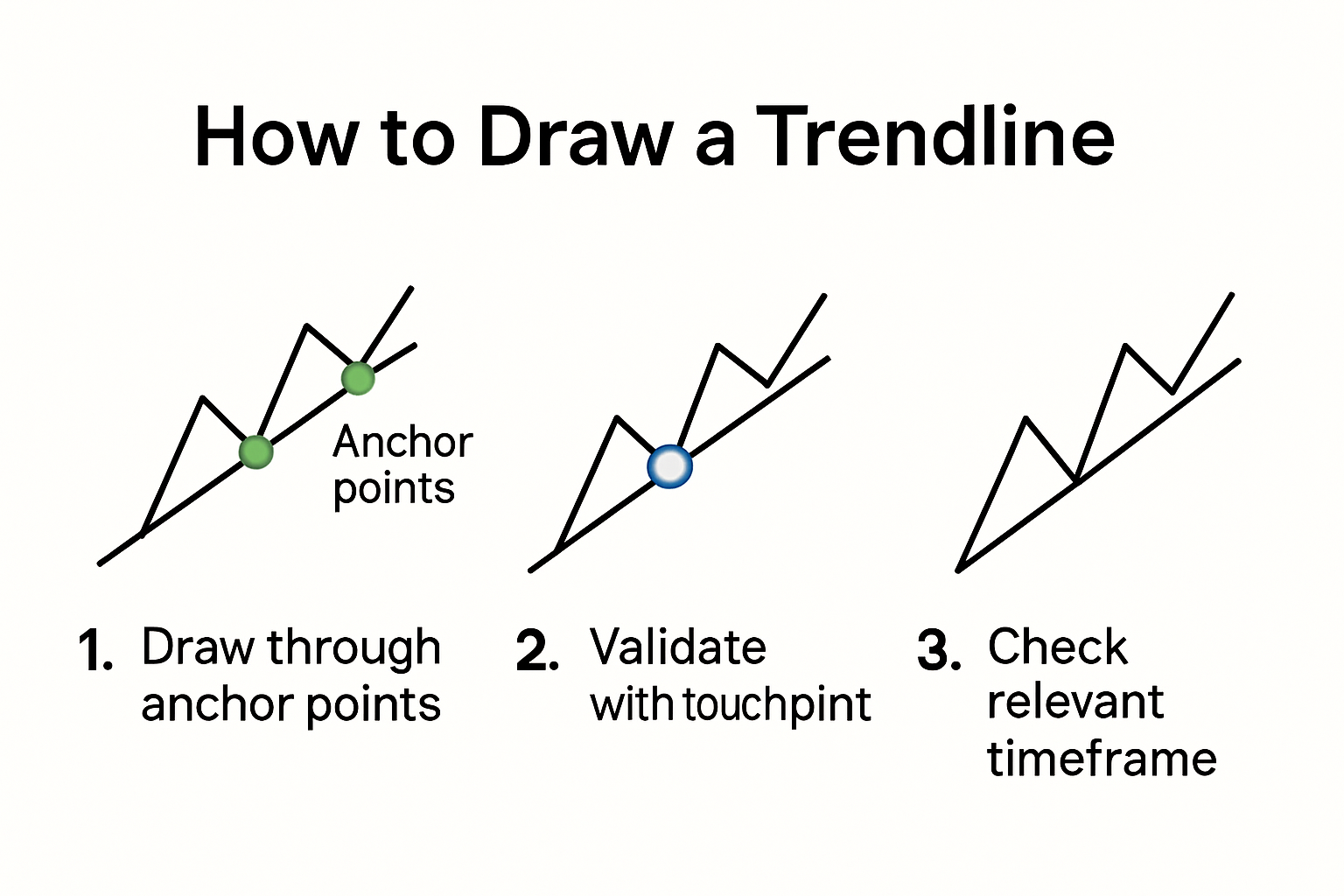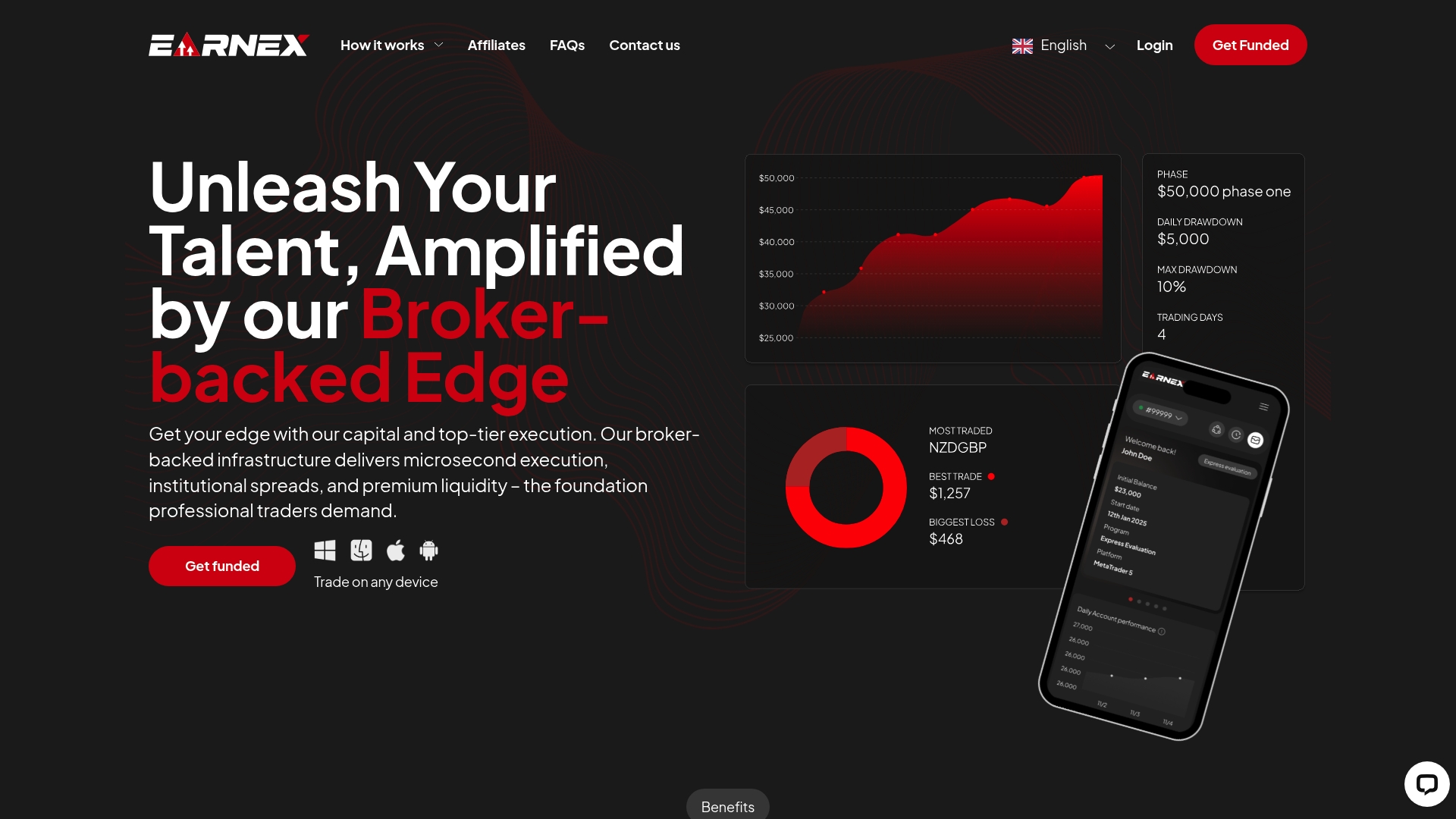Trading With Trendlines: Pro Strategies for 2025 Success

Many traders use trendlines to spot opportunities in the forex market, claiming it is a foundational skill for long-term success. Here’s something that might surprise you. Advanced algorithmic models have now achieved a mind-bending Root Mean Squared Error of just 2.407×10⁻³ when predicting forex price moves using event-driven LSTM techniques. Most people still think trendlines are just about drawing lines on a chart, but with strategies like these, the rules for trading in 2025 are changing faster than most realize.
Table of Contents
- Mastering Trendline Basics For Forex Pros
- Identifying High-Probability Trades With Trendlines
- Advanced Risk Management Using Trendlines
- Scaling Capital And Navigating Funded Accounts
Quick Summary
| Takeaway | Explanation |
|---|---|
| Master Trendline Construction | Accurate trendline drawing is crucial; connect at least two significant price points and ensure at least three interactions for validation. |
| Employ Advanced Analytical Techniques | Use techniques like trend angle assessment and intersection points to derive deeper market insights and enhance trading strategies. |
| Implement Comprehensive Risk Management | Effective risk management strategies include stringent stop-loss placement, adaptive position sizing, and psychological frameworks to maintain discipline during trading. |
| Focus on Continuous Learning and Adaptation | The forex market is dynamic; successful traders must adapt their strategies and continuously learn to maintain a statistical edge in trade setups. |
| Dynamic Capital Scaling Practices | Use performance milestone tracking and risk-adjusted capital allocation to strategically scale trading capital in funded accounts. |
Mastering Trendline Basics for Forex Pros
Trading with trendlines represents a fundamental skill that separates professional forex traders from novices. These critical graphical tools provide traders with powerful insights into market momentum, price action, and potential trend reversals. Understanding how to draw, interpret, and trade using trendlines can significantly enhance a trader’s ability to make informed decisions in the volatile forex market.
The Science Behind Trendline Construction
Drawing accurate trendlines requires precision and strategic thinking. Research utilizing deep learning networks has demonstrated that technical analysis techniques like trendline identification play a crucial role in predicting market movements. Professional traders typically connect at least two significant price points to create a meaningful trendline, focusing on identifying key highs or lows that represent genuine market sentiment.
When constructing trendlines, traders must consider several critical factors:
- Price Confirmation: Select points that represent clear market turning points
- Multiple Touchpoints: Stronger trendlines have 3-4 validated price interactions
- Timeframe Relevance: Match trendline construction to your specific trading strategy
To clarify the key factors in constructing high-quality trendlines, see the table below summarizing trader best practices:
| Factor | Description | Best Practice Example |
|---|---|---|
| Price Confirmation | Select significant market turning points | Use established highs or lows |
| Multiple Touchpoints | Number of price interactions along the trendline | 3-4 touches increase trendline strength |
| Timeframe Relevance | Align trendline with your trading timeframe | Match line to day, swing, or position trades |

Advanced Trendline Analysis Techniques
Professional forex traders go beyond simple line drawing by incorporating sophisticated analytical approaches. An advanced algorithmic framework suggests using predictive coding networks to enhance trend identification and market analysis. This means looking beyond basic linear connections and understanding the nuanced signals embedded within price movements.
Key advanced techniques include:
- Trend Angle Assessment: Analyzing the slope of trendlines to gauge market momentum
- Intersection Points: Identifying where multiple trendlines create potential trading signals
- Timeframe Correlation: Comparing trendlines across different trading periods for comprehensive market understanding
Predictive Modeling and Trendline Strategies
Cutting-edge research has transformed trendline analysis from a subjective art to a more scientific approach. An event-driven LSTM model demonstrated remarkable precision in predicting forex price movements, achieving a Root Mean Squared Error of just 2.407×10⁻³. This breakthrough highlights the potential of combining traditional technical analysis with advanced computational techniques.
Traders can leverage these insights by:
- Implementing systematic trendline validation processes
- Using machine learning algorithms to confirm traditional technical analysis signals
- Developing robust trading strategies that integrate multiple analytical approaches
Mastering trendlines requires continuous learning and practice. While the basics might seem straightforward, professional traders understand that true expertise comes from consistent application and adaptive thinking. Learn more about advanced trading evaluation techniques to refine your trendline trading skills and prepare for complex market scenarios.
Remember that trendline analysis is not about perfect prediction but about understanding probabilistic market movements. By combining technical skills, computational insights, and strategic thinking, forex professionals can transform trendlines from simple graphical tools into powerful decision-making instruments.
Identifying High-Probability Trades with Trendlines
Successful forex trading hinges on identifying high-probability trade setups with precision and strategic insight. Trendlines serve as powerful tools for traders seeking to extract maximum value from market movements while minimizing potential risks. Understanding how to transform these graphical indicators into actionable trading strategies requires a sophisticated approach that combines technical analysis with statistical probability.
Confirming Trade Entry Points
Identifying reliable trade entry points demands more than simple visual pattern recognition. Research on momentum strategies suggests that integrating deep learning techniques can significantly enhance trade probability assessment. Professional traders look for multiple confirmation signals when using trendlines:
- Trend Validation: Ensure the trendline connects at least three significant price points
- Angle of Momentum: Analyze the trendline’s slope to gauge market strength
- Timeframe Confirmation: Validate signals across multiple trading periods
Interesting insights from trend-following strategy analysis reveal that market volatility directly impacts trade success rates. As market conditions become more unpredictable, the probability of winning trades decreases, underscoring the importance of robust confirmation techniques.
Advanced Probability Assessment Techniques
Traders can elevate their trendline analysis by implementing sophisticated probability assessment methods. Research on MACD-based trading strategies demonstrates the power of combining multiple technical indicators to improve win rates and risk-adjusted performance. Key approaches include:
- Confluence Analysis: Identify where multiple technical indicators converge
- Volume Confirmation: Use trading volume to validate trendline signals
- Support and Resistance Alignment: Match trendlines with key price levels
Risk Management and Probability Optimization
High-probability trading is not just about entry points but comprehensive risk management. Successful traders understand that probability is a nuanced concept requiring continuous refinement. Explore our advanced trading evaluation methods to develop a more sophisticated approach to trade probability assessment.
Key risk management strategies include:
- Implementing strict stop-loss mechanisms
- Calculating precise position sizing based on probability metrics
- Maintaining a disciplined approach to trade selection
Professional traders recognize that high-probability trades are not about guaranteed outcomes but about creating a statistical edge. By combining technical analysis, advanced computational techniques, and rigorous risk management, traders can develop a robust framework for identifying and executing high-probability trendline trades.
Remember that market conditions are dynamic. What works today might require adjustment tomorrow. Continuous learning, adaptability, and a data-driven approach are the hallmarks of traders who consistently identify and capitalize on high-probability trading opportunities.
Advanced Risk Management Using Trendlines
Risk management represents the cornerstone of sustainable trading success, and trendlines offer sophisticated traders a powerful mechanism for quantifying and mitigating potential market risks. Professional forex traders understand that effective risk management goes far beyond simple stop-loss placement – it involves a comprehensive approach to understanding market dynamics, volatility, and potential drawdown scenarios.
Quantitative Risk Assessment Techniques
Research on identifying risk extreme values demonstrates the critical importance of advanced statistical methods in analyzing time series data. Traders can leverage trendlines as dynamic risk assessment tools by implementing several strategic approaches:
- Volatility Bands: Use trendline angles to create adaptive volatility measurement zones
- Drawdown Prediction: Analyze trendline slope changes to anticipate potential market corrections
- Probabilistic Risk Calculation: Develop statistical models that integrate trendline momentum and historical price behavior
Professional traders recognize that risk is not a static concept but a dynamic, continuously evolving parameter that requires sophisticated analytical techniques. The ability to transform graphical trendlines into quantitative risk metrics separates exceptional traders from average performers.
Dynamic Stop-Loss and Position Sizing Strategies
Trendlines provide more than visual trend indicators – they serve as precision instruments for implementing adaptive risk management strategies. By understanding trendline mechanics, traders can develop nuanced approaches to stop-loss placement and position sizing that respond dynamically to market conditions.
Key strategies include:
- Trailing Stop Techniques: Use trendline intersections to adjust stop-loss levels automatically
- Adaptive Position Sizing: Calculate position sizes based on trendline slope and market volatility
- Multi-Timeframe Risk Analysis: Cross-reference trendlines across different trading periods for comprehensive risk assessment
To help traders compare the range of dynamic risk management strategies discussed, the following table offers a concise overview:
| Strategy Type | Approach Description | Application Example |
|---|---|---|
| Trailing Stop Techniques | Adjust stop-loss levels at trendline intersections | Move stop after each trendline touch |
| Adaptive Position Sizing | Vary position size by trendline slope & volatility | Reduce size in high-volatility scenarios |
| Multi-Timeframe Analysis | Use trendlines from several periods for risk decisions | Blend daily/weekly trends for confirmation |
Psychological Risk Management Frameworks
Beyond mathematical calculations, advanced risk management involves understanding the psychological dimensions of trading. Trendlines can help traders maintain emotional discipline by providing objective, data-driven decision-making frameworks. Learn more about our professional trading evaluation processes to develop a holistic approach to risk management.
Essential psychological risk management techniques include:
- Establishing predetermined risk tolerance levels
- Creating systematic trading protocols based on objective trendline signals
- Developing mental resilience through structured trading methodologies
The most successful traders view risk management not as a restrictive mechanism but as a strategic advantage. By transforming trendlines from simple graphical tools into comprehensive risk assessment instruments, professionals can create robust trading frameworks that balance potential rewards with carefully calculated risk exposure.
Remember that risk management is an ongoing learning process. Market conditions evolve, and trading strategies must adapt accordingly. Continuous education, data analysis, and a commitment to systematic approach will ultimately determine a trader’s long-term success in the complex world of forex trading.
Scaling Capital and Navigating Funded Accounts
Scaling capital in funded trading accounts represents a sophisticated challenge that demands strategic precision, disciplined execution, and advanced technical analysis. Professional traders understand that successful capital scaling goes beyond mere performance metrics – it requires a comprehensive approach integrating trendline analysis, risk management, and adaptive trading strategies.
Dynamic Capital Scaling Strategies
Research on trend-following strategies reveals the importance of dynamically adjusting momentum learning techniques during market transitions. Traders can implement sophisticated capital scaling approaches by:
- Adaptive Position Sizing: Incrementally increase position sizes based on consistent performance
- Performance Milestone Tracking: Establish clear capital scaling thresholds
- Risk-Adjusted Capital Allocation: Match position sizes with validated trading performance
Professional traders recognize that capital scaling is not a linear process but a nuanced strategy requiring continuous assessment and strategic recalibration. The ability to dynamically adjust trading parameters separates exceptional funded account traders from average performers.
Advanced Trendline-Based Performance Optimization
Innovative research on price trend trading demonstrates how advanced image analysis and machine learning techniques can enhance trading strategy performance. By integrating sophisticated analytical approaches, traders can develop robust frameworks for capital scaling:
- Predictive Pattern Recognition: Utilize deep learning techniques to identify emerging market trends
- Multi-Timeframe Momentum Analysis: Cross-validate trading signals across different market periods
- Statistical Performance Modeling: Develop quantitative frameworks for consistent capital growth
Navigating Funded Account Challenges
Successful funded account management requires more than technical skills – it demands a holistic approach to trading psychology and strategic execution. Explore our comprehensive funding evaluation process to understand the intricate requirements of professional trading accounts.
Key strategies for funded account success include:
- Maintaining consistent risk management protocols
- Developing psychological resilience during market volatility
- Creating systematic approaches to performance documentation
The most successful funded account traders view capital scaling as a structured, methodical process. They understand that sustainable growth requires a combination of technical expertise, disciplined execution, and continuous learning. By transforming trendline analysis into a comprehensive performance optimization tool, professionals can navigate the complex landscape of funded trading accounts with confidence and strategic precision.
Remember that funded account success is not about individual trade outcomes but about demonstrating consistent, controlled trading performance. Continuous education, data-driven decision-making, and a commitment to systematic improvement will ultimately determine a trader’s long-term success in the competitive world of professional trading.
Frequently Asked Questions
What are trendlines in forex trading?
Trendlines are essential tools used in forex trading to connect significant price points on a chart, helping traders identify market direction and potential reversal points.
How do I draw an effective trendline?
To draw an effective trendline, connect at least two significant price points and ensure there are three or more interactions with the line for validation. This increases the reliability of the trendline.
What advanced techniques can I use with trendlines?
Advanced techniques include analyzing trend angle assessments, identifying intersection points with other trendlines, and using multiple timeframes to enhance market understanding and trade accuracy.
How can I manage risk while trading using trendlines?
Effective risk management can be achieved by implementing strict stop-loss placements, calculating position sizes based on market conditions, and maintaining discipline through emotionally resilient trading strategies.
Turn Your Trendline Mastery Into Real Funded Opportunities
If you have been honing your trendline strategies and advanced risk management skills, but still find limited capital a barrier to your trading growth, you are not alone. Many talented traders know how to identify high-probability setups and optimize risk, yet lack the financial resources or institutional support to scale their results. The frustration of being ready for market success, but unable to take the next big step, is real for any dedicated trader.

Put your pro strategies to work in a real-world environment. At Earnex Prime, you can prove your trading skills in evaluation challenges designed around strict profit targets, drawdown limits, and disciplined risk frameworks—just like the advanced concepts explored in the article. Once you pass, you will get access to significant trading capital and generous profit splits in a transparent, broker-backed setting. Don’t let another trading year go by without scaling up your expertise. Apply for a funded trading account now and see how your trendline edge performs when managing real capital. Your next level success starts at funded.earnexprime.com.








